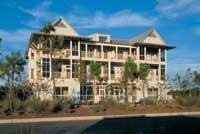Water Smart Keeping a landscape design alive takes more than plants. It also requires water–billions and billions of gallons of it. To save money and conserve water, many multifamily owners and developers are turning to more sophisticated systems and land plans.
At AvalonBay Communities, the solution has been to set up computerized and mechanical water monitoring systems. “We are using a couple of different water monitoring systems, including rain gauges that prevent sprinklers from turning on during or immediately after a rain, and we are contracting with outside vendors who use software to control sprinkler systems based on specific rainfall in a community,” says James Willden, vice president of engineering, who estimates the company has saved more than 114 billion gallons of water and $351,000 in water expenses in the past four years since it added the systems.
At Arvida’s WaterColor development, water conservation is achieved through increasingly accepted landscaping practices such as native plants and manmade ponds for storm water retention. Saving natural “scrub” areas that include slash pines, saw palmettos, sand pines, native vegetation, and grasses has reduced the need for watering extensive amounts of non-native plantings, even though it takes some people time to gain appreciation of scrub landscaping, according to Jim Pettigrew, a sales associate at WaterColor.
Taking a creative landscaping approach to minimizing storm water run-off helped get the maximum building area for Christina Landing in Wilmington, Del., says Robert Maloney, the project’s landscape architect. The strategies included capping the former brownfield with 18 inches to 24 inches of topsoil, whose different depths create low-lying areas that retain water. Buccini/Pollin Group’s 8-acre development will include 63 townhomes and a 22-story residential tower but will still make room for 15 retention areas.
